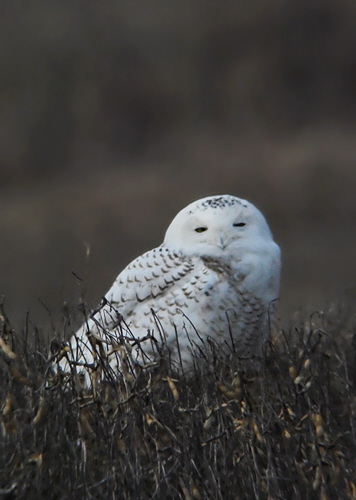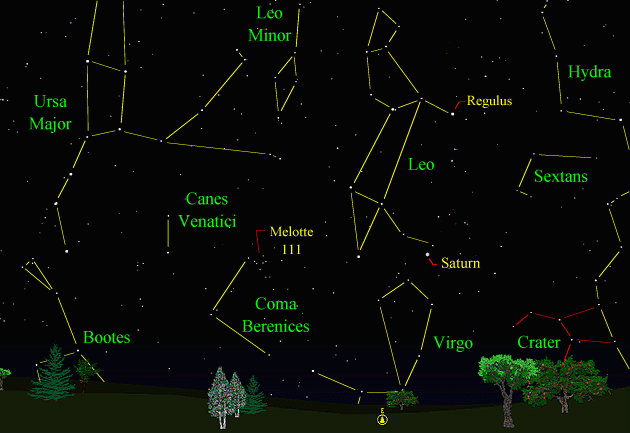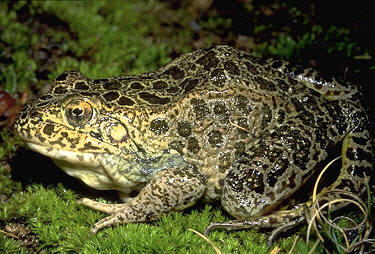The purpose of this feature is to give scout leaders, educators and naturalists an idea of some of the natural events coming up each month. We will try to cover a variety of natural events ranging from sky events to calling periods of amphibians, bird and mammal watching tips, prominent wildflowers and anything else that comes to mind. We will also note prominent constellations appearing over the eastern horizon at mid-evening each month for our area for those who would like to learn the constellations. If you have suggestions for other types of natural information you would like to see added to this calendar, let us know! Note: You can click on the hyperlinks to learn more about some of the featured items. To return to the Calendar, hit the "back" button on your browser, NOT the "back" button on the web page. All charts are available in a "printer friendly" mode, with black stars on a white background. Left clicking on each chart will take you to a printable black and white image.
Notes and Images From January 2009
A Winter Visitor: In early December a Snowy Owl appeared on the grounds of the General Motors plant in Spring Hill, Tennessee. Local birders did not discover the bird until the middle of January. Although not a rare owl in the north, it is unusual for these birds to appear this far south. Snowy Owls make periodic "invasions" southward, and most birds seen in this part of the country are immatures like the bird at Spring Hill. Varying owl populations, and shortages of prey farther north, are generally thought to trigger the invasions. Ten appearances have been documented since 1918. The last documented Snowy Owl, in January, 1987, was discovered near Dover, Tennessee by John Robinson. John first spotted the bird on the railing of the Dover bridge! The last bird prior to that was in Nashville in 1960, in the area now occupied by Metro Center. The largest recorded invasion in Tennessee was in the winter of 1930, when four birds were found. There are records of Snowy Owls as far south as Georgia, Louisiana and Texas. The Snowy Owl is the largest owl that we have in Tennessee. It is also the largest owl by weight in North America. With a wing span that can exceed 60 inches, it is a beautiful bird to watch in flight. As of February 8th, the Snowy Owl at Spring Hill was still being seen.
The MTSU Four Season Virtual Tree Trail, for which Leaps did the imaging and recordings, is online this month. The virtual trail features many aspects of tree identification and uses a dichotomous key hyperlinked to an illustrated glossary to teach how dichotomous keys are used. The virtual trail is based on a real tree trail at Barfield Crescent Park in Murfreesboro, Tennessee and we hope it encourages people to visit the park and experience the beauty of this trail first hand. Visit the virtual tree trail at www.mtsu.edu/mtsucee.
Sky Events for February 2009: Comet Lulin has brightened to naked eye visibility in dark skies, although I had to use averted vision to see it around 1:00am on February 17th. It is best to use binoculars, and the comet appears as a fairly bright round fuzzy patch of light. I found the bright star Spica first, then moved my binoculars up toward Leo to spot the comet. You can go to the March 2008 Natural Calendar sky chart to see the stars in this area. Towards the end of the month the comet will move up into Leo. For finder charts, click here. Evening Sky: Bright Venus continues to blaze away in the southwestern sky after sunset, and outshines all of the other stars and planets. As the month progresses it will set earlier in the evening. Venus will pass between Earth and the Sun in March, and if you have binoculars on a steady support, you probably will be able to see a tiny crescent Venus by the end of the month. The trick is to look at Venus just as soon as you can find it against the bright twilight sky (but wait till the sun is below the horizon, see below). If you wait until later in the evening, Venus becomes a dazzling target, and little detail is seen. If you visualize Venus passing between Earth and the Sun, you will expect to see the crescent appearing both thinner and larger as it approaches conjunction. This continues into March. As Venus approaches the sun, you must make sure that the sun has set before you begin looking for it. If you chance to sweep across the sun when using binoculars, you could permanently damage your eyes. Saturn rises a little after 7:00pm at mid-month in Leo. The rings are almost edge-on at this time. Morning Sky: Mercury, Mars and Jupiter all appear in the dawn sky in February. Mars, in particular, is faint, and binoculars will help locate all three planets. Try looking east-southeast about 30 minutes before sunrise. You will need a fairly flat horizon. On February 16th, find Mercury first, then look down and to the left of Mercury for Jupiter. Using binoculars you should be able to spot faint Mars just to the right of Jupiter. On February 22nd, the crescent Moon helps locate the three planets. Find the thin waning crescent Moon first, then with binoculars look down and to the left of the Moon for Mercury, then Jupiter and then Mars, in that order.
Constellations: The views below show the sky looking east at 9:00pm CST on February 15th. The first view shows the sky with the constellation outlines and names depicted. Star and planet names are in yellow. Constellation names are in green. The second view shows the same scene without labels. Leo, the Lion, is prominent with its bright star Regulus. Below the rear foot of the lion is the bright planet Saturn. Use Regulus and Saturn to guide you to the faint constellation of Sextans, the Sextant. Conspicuous in the northeast is Ursa Major, the Great Bear. The constellations of Bootes, the Herdsman, Coma Berenices, Berenice's Hair, Virgo, the Virgin and Crater, the Cup are all just making their way above the horizon and will be seen better next month. If you can't wait, you can always stay up a little later and watch them rise.
On Learning the Constellations: We advise learning a few constellations each month, and then following them through the seasons. Once you associate a particular constellation coming over the eastern horizon at a certain time of year, you may start thinking about it like an old friend, looking forward to its arrival each season. The stars in the evening scene above, for instance, will always be in the same place relative to the horizon at the same time and date each February. Of course, the planets do move slowly through the constellations, but with practice you will learn to identify them from their appearance. In particular, learn the brightest stars (like Regulus in the above scene looking east), for they will guide you to the fainter stars. Once you can locate the more prominent constellations, you can "branch out" to other constellations around them. It may take you a little while to get a sense of scale, to translate what you see on the computer screen or what you see on the page of a book to what you see in the sky. Look for patterns, like the stars of the "Big Dipper." The earth's rotation causes the constellations to appear to move across the sky just as the sun and the moon appear to do. If you go outside earlier than the time shown on the charts, the constellations will be lower to the eastern horizon. If you observe later, they will have climbed higher. As each season progresses, the earth's motion around the sun causes the constellations to appear a little farther towards the west each night for any given time of night. If you want to see where the constellations in the above figures will be on March 15th at 9:00pm CST, you can stay up till 11:00pm CST on the February 15th and get a preview. The westward motion of the constellations is equivalent to two hours per month. For instance, if you want to see what stars will be on your eastern horizon on May 15th at 9:00pm CST (3 months from now), you would need to get up at 3:00am CST on February 15th (3 months times 2 hours/month = 6 hours). Recommended: Sky Publishing has a beautiful and compact star atlas, the Sky & Telescope's Pocket Star Atlas. It is destined to become a classic, and is a joy to use at the telescope. A good book to learn the constellations is Patterns in the Sky, by Hewitt-White. You may also want to check out at H. A. Rey's classic, The Stars, A New Way to See Them. For skywatching tips, an inexpensive good guide is Secrets of Stargazing, by Becky Ramotowski. A good general reference book on astronomy is the Peterson
Field Guide,
A Field Guide to the Stars and Planets, by Pasachoff. The book retails for around $14.00. Starry Night has several software programs for learning the night sky. Visit the Starry Night web site at www.starrynight.com for details.
Amphibians:
The amphibian season continues to build in February. One trick to finding amphibians in winter is to go out on mild (50 degrees Fahrenheit or warmer) rainy nights. For safety, it is important that you have another person with you to help watch for traffic as you slowly drive the back roads. Look for things that cross the road in front of you and stop frequently and listen. Early breeding frogs like Upland Chorus Frogs, Spring Peepers and Wood Frogs are already calling by the first of the month. I've also already heard Southern Leopard Frogs calling this year. Spotted Salamanders and Tiger Salamanders also breed in January and February, and the eggs of both can often be found this time of year. Towards the end of the month, given mild temperatures, you can sometimes hear American Toads beginning to call. In west Tennessee, Crawfish Frogs give their loud snoring calls starting in late February and continuing on into early March. At higher elevations, listen for Mountain Chorus Frogs towards the end of the month. Remember that on mild nights you may find frogs and toads out foraging that you do not hear until later in the season.
Birds: Many times when we have been out looking for amphibians in February we've witnessed courtship flights of the American Woodcock. Listen for the "peent" call at dusk and watch as the male Woodcock spirals upward till it's almost out of sight, then dives back to the ground, twisting and turning. For more about watching American Woodcocks see, "The Woodcock's Call." Red-Shouldered Hawks mate as early as February in Tennessee. Watch for courtship activities of these and other hawks. Stick Nests: With the leaves down, this is a great time of year to find raptor stick nests. I make notes of all the nests I find and then periodically check them to see if anyone has "moved in." Many times Great Horned Owls make use of an old Red-Tailed Hawk's nest from the previous year. The owls can already be incubating eggs in January. Of the hawks, Arthur Cleveland Bent, in his "Life Histories of North American Birds of Prey," writes, "[Red-tailed Hawks]...begin their nest building late in February or early in March; I have seen a wholly new nest half completed and decorated with green pine twigs and down as early as February 18th, over a month before the eggs are laid...Typical nests are from 28 to 30 inches in outside diameter, the inner cavity being 14 or 15 inches wide and 4 or 5 inches deep...The nests are well made of sticks and twigs, half an inch or less in thickness, and neatly lined with strips of inner bark, of cedar, grapevine or chestnut, usnea, and usually at least a few green sprigs of pine, cedar or hemlock. Some nests are profusely and beautifully lined with fresh green sprigs of white pine, which are frequently renewed during incubation and during the earlier stages of growth of the young...They "stake out their claim" late in February or early in March...by marking the nest they propose to use with a sprig of green pine...I believe that the birds prefer to build a new nest each year, but they sometimes use the same nest for consecutive years..." Bent was writing about the Red-Tail Hawks in New England, so our times could be a little earlier. You probably have already put out your bird feeders, but if you havenít you're missing out on a lot of good looks at winter feeder birds. This is a great time of year to start learning your birds. Watch and listen for winter residents such as White-throated and White-crowned Sparrows, Yellow-bellied Sapsuckers, Red-breasted Nuthatches, Golden-crowned Kinglets and Brown Creepers. Recommended: Bird Finding in Tennessee, Michael Lee Bierly. A classic guide to finding birds in Tennessee. The Sibley Guide to Birds, David Allen Sibley The Sibley Guide to Birds of Eastern North America, David Allen Sibley This new Sibley Guide covers only eastern North America, is quite compact, and is less expensive than the larger Sibley. An inexpensive guide for beginners is the Golden Guide for Birds.
Archives (Remember to use the back button on your browser, NOT the back button on the web page!) Natural Calendar December 2008 Natural Calendar November 2008 Natural Calendar September 2008 Natural Calendar February 2008 Natural Calendar December 2007 Natural Calendar November 2007 Natural Calendar September 2007 Natural Calendar February 2007 Natural Calendar December 2006 Natural Calendar November 2006 Natural Calendar September 2006 Natural Calendar February 2006
Natural Calendar
December 2005
Natural Calendar
November 2005
Natural Calendar
September 2005
Natural Calendar
February 2005
Natural Calendar
December 2004
Natural Calendar
November 2004
Natural Calendar
September 2004
Natural Calendar
February 2004
Natural Calendar
December 2003
Natural Calendar
November 2003
Natural Calendar
September 2003 Natural Calendar February 2003 Natural Calendar December 2002 Natural Calendar November 2002 Nature Notes Archives: Nature Notes was a page we published in 2001 and 2002 containing our observations about everything from the northern lights display of November 2001 to frog and salamander egg masses. Night scenes prepared with Starry Night Pro software All images and recordings © 2009 Leaps |



